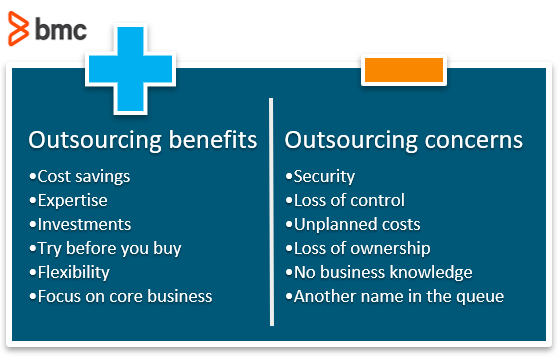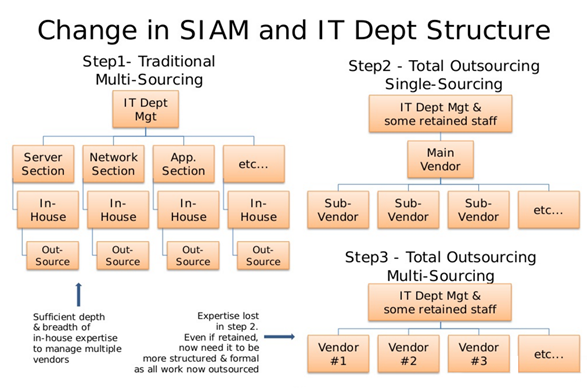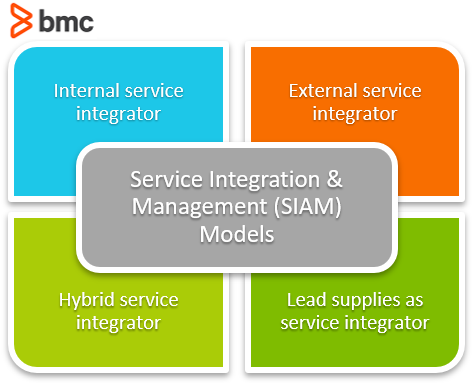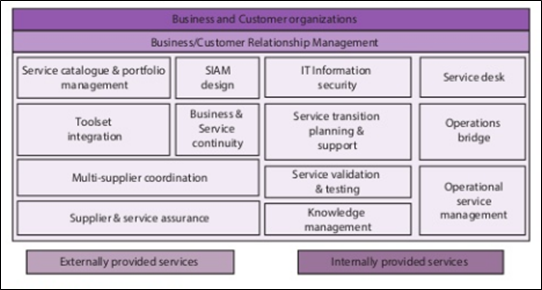Information technology is one of the most demanding industries in today’s rapidly changing world. You would be hard pressed to find any service that does not rely, to some extent, on IT to function.
Even the most basic of agricultural tasks, which would previously have been 100% manual, will now utilize technology, improving productivity and efficiency in the process.
Ten or twenty years ago, your average IT worker was a skilled generalist who could confidently turn their hand to virtually anything that was technology based. In 2021 that is no longer the case. We now rely on narrowly focussed specialists to keep the lights on and the innovations coming.
Even the largest of organizations with the biggest IT budgets will struggle to justify keeping infrequently used specialist skills within their organization.
This means that we need to share these specialists via an outsourcing model, thus providing the best value to our organizations.
Outsourcing: What’s the big deal?
To some people, “outsourcing” is a bad word. It is seen by some as a way to rid organizations of staff, replacing them with contract resources. Any mention of outsourcing is seen as a threat to the internal IT team.

Certainly, outsourcing is not without risk. But I prefer to think of it as an opportunity, one where you are both:
- Letting your own team concentrate on what they are good at.
- Learning new skills from an external specialist.
Outsourcing simply makes sense in a variety of situations. In the case of low-value, commodity IT capability, there are compelling reasons to use external parties as suppliers.
Why set up your own data center, staff it, and maintain it, if this is not your core business?
It is far more sensible to outsource the responsibility in this space to a specialist provider, letting you get on with your own core business, while they take care of theirs.
When you are looking at infrequently used, specialist IT capability, it does not make economic sense to pay for in-house expensive resources who will only be used on rare occasions. Instead, it’s far better to outsource this capability to businesses for whom this is their daily responsibility. They will have more experience and understanding of the systems that you are using.
Successful IT departments will use a mix of insourcing and outsourcing, making best use of what can be scarce resources. The key to success is being able to:
- Coordinate your internal and external resources effectively and efficiently.
- Provide the best outcomes for your organization.
(Read our primer on outsourcing & insourcing.)
The SIAM solution
This coordination is what Service Integration and Management (SIAM) systems are designed to enable.
SIAM is an outsourcing service model drawn from the success of major corporations around the world. The term can be used interchangeably with Multisourcing Services Integration (MSI). It is also sometimes referred to as SIAM/MSI. Any of the above names are appropriate.
At its core, SIAM provides guidance on good practice in managing multiple suppliers of IT services.
(See how SIAM works with ITIL®.)
In traditionally run IT departments, trained in-house professionals are selected to oversee various functions like network efficacy or database management. These professionals may find it necessary to outsource some requirements to vendors, completing the remaining work in-house.
One example might be an IT department that outsources the implementation of a new database to an external vendor but manages the data, training, and user adoption in-house.
This piecemeal approach can lead to a disjointed vendor management strategy, based on the premise that you can bring vendors in on an as-needed basis to work however they see fit without direction and oversight of in-house IT managers. That approach can be highly problematic—there is no single point of oversight of these vendors.
For example, it’s in no way uncommon to find single vendors having multiple contracts with different parts of a single organization, with varying conditions and costs.
IT Management may elect to outsource all their external work to one vendor. But the trouble is that most single vendor solutions aren’t equipped to handle every IT problem. This means that the vendor may end up subcontracting some work to third parties, which offers the hiring organization:
- Very little transparency
- Very little quality control
It is out of these models that SIAM was born. It’s the strategic process which gives an IT department the framework it needs to efficiently manage multiple vendors to accomplish organizational goals with full oversight over the process and with appropriate quality control measures in place.

Using SIAM and multi-sourcing to solve IT problems
Using SIAM to manage a multi-sourced IT capability can resolve many issues faced by today’s IT organization.
If you have, or currently are, experiencing any of the issues listed here, it is time for you to investigate taking a SIAM based approach to your vendor management:
- Unclear delineation of duties among vendors
- Lack of cooperation and coordination between vendors
- Little accountability and no transparency of vendor processes and benchmarks for completion
- Leadership discouraged by lack of innovation among vendors who are eager to fulfill a contract
- Reporting on quality assurance is costly and labor intensive for vendors
- You have a growing need to deliver a number of diverse IT services
- You are seeing an increase in the complexity of the services you need to provide
- You have 24/7 operational needs
- You are seeing an increase in internal and external customer expectations
- You currently have no set standards for measuring vendor performance
If any of these statements sound familiar to you, then it is time to review the way you manage your current pool of vendors, and the SIAM model is a very good place to start.
SIAM is solutions-oriented
If you’re going to change your IT outsourcing strategy, you need to ensure you are making a change for the better, not just changing for the sake of change. If you do not take the time to fully understand the SIAM model you plan to employ, you could simply swap one set of problems for another.
It’s important to validate the SIAM models against your own requirements and select the appropriate way of working. If you do not do this you risk running into a number of problems:
- SIAM becomes more costly than the benefit received
- No benefits are being received
- Service quality deteriorates
- The selected SIAM model does not scale appropriately
- The SIAM model you employ causes an increased need for costly company resources
These issues can occur for several reasons, including:
- Lack of consensus and understanding by management regarding SIAM activities, approach and application
- Failure to understand the capabilities of SIAM software providers and the solutions they offer
- Incomplete or absent benchmarks and metrics to determine SIAM success
- Inadequate training of in-house service integrators
Having a clear understanding of best practice for SIAM and the different models that are available will allow you to effectively mitigate any risks that could be costly to your business.
Understanding SIAM models
There are four common SIAM models that fit most situations—and you need to select the one that works best for your own situation. That decision will be impacted by:
- The level of SIAM expertise within your organization
- The complexity of the systems you are managing
- The ability and availability of specialist SIAM services
Let’s look briefly at the four SIAM models.

Internal service integrator
In this model, the control of the various vendors remains within your organisation.
This can be a cost-effective model. However, if the person charged with managing this model is not skilled in service integration, or does not have sufficient authority, it is unlikely to provide the expected benefits.
External service integrator
In this model a specialist, independent service integrator is responsible for managing all vendor relationships on your behalf. They will have significant experience in vendor management.
The downside to this way of working is that the cost of employing a specialist company will be high, although the benefits of having a highly experienced, independent management team can be significant enough to make the investment worthwhile.
Hybrid service integrator
This model combines the internal and external service integrator models, with, perhaps, an internal resource managing a group of smaller vendors and a specialist company taking responsibility for your most critical vendor relationships.
This is a common model which may then move to the fully internal service integrator once your own team has built up its knowledge and experience in the SIAM world.
Lead supplier as service integrator
This model will see one of your key suppliers taking over the management of other vendors. This arrangement needs to have a high level of trust between you and your key vendor. Where this trust exists, this arrangement can be a very successful way of working.
Wherever possible it’s useful to consolidate areas of necessity into one vendor relationship.
For instance, instead of hiring nine vendors to service each of your IT infrastructure needs, hire three vendors who each cover three of the requirements. Even if they subcontract the work you are going to enter into a single agreement with each of them that ensures quality standards are met.

SIAM Best Practices
Using good practice allows businesses to safeguard themselves against any potential risks associated with changing their outsourcing strategy.
Create a vendor agreement
Your Vendor Agreement is the binding document between your company and a supplier, that ensures that both:
- Your end user’s expectations are being delivered on
- Your company’s mission is being furthered
Some things to include are:
- Cooperation clauses between vendors
- A service management manual with guidelines
- Key performance indicators (KPIs) that will help determine the success of the vendor relationship
Tracking and reacting to non-performance against these KPIs in a timely manner is critical to success, regardless of which SIAM model you decide to employ.
Build relationships
By building relationships with your vendors you take the experience beyond a transaction and inspire others to focus on your brand’s mission. If one relationship should go awry you have a backup plan with your other vendors who value the relationship you’ve built to complete the work.
A successful vendor relationship must be beneficial to both sides: You need your vendor to be successful. If they are not, your organization will ultimately suffer.
There must be fairness and some level of give-and-take and mutual understanding, as with any relationship, business or otherwise.
(Understand the Business Relationship Manager role.)
Ensure you’re set up for a multi-vendor approach
This one takes a little more finesse. A good start is designating a layer of vendor management that provides input in the decision about which functions to outsource, manages vendor relationships, and implements quality assurance.
This is like Human Resources for vendors.
Use the right tools for SIAM
Select a tool for your SIAM that has service and performance management. The right tool will make sure there are no gaps that could allow accountability and transparency to be sacrificed.
If selecting among multiple vendors, ensure you understand all the differences between each platform before making a decision.
Switching to SIAM
In the end, each business must weigh pros versus cons and decide what approach is best for their vendor situation and unique IT requirements. Some level of SIAM is becoming essential in today’s complex IT environment, where very few organizations can afford to hold all the required expertise in-house.
For any business that is struggling to come to terms with the complexity of their IT situation, those who are wondering if the output they are getting is providing a seamless, high-quality experience for end users, SIAM is an option worth exploring.
For some who are considering the switch, it may make sense to compartmentalize each component of SIAM before diving in. As mentioned, the biggest issues arise when companies immerse themselves in SIAM, without a deep understanding of it.
A component model allows businesses to take inventory of each necessity along the way at the beginning of a transition to a SIAM provider. It aids leadership in gaining a clear picture of the overall functionality, so everyone is on the same page.
In visual form, a component approach to SIAM might look something like this:

Whatever approach you select, it’s important to understand all the risks, benefits, and resources involved when it comes to Service Integration and Management.
A well thought-out, meticulously planned and executed transition to a SIAM model will provide benefits to your organization, regardless of size or complexity. You will certainly:
- Free up your own staff to concentrate on your core business.
- Save precious resources by only paying for the IT services you actually need, when you need them.







